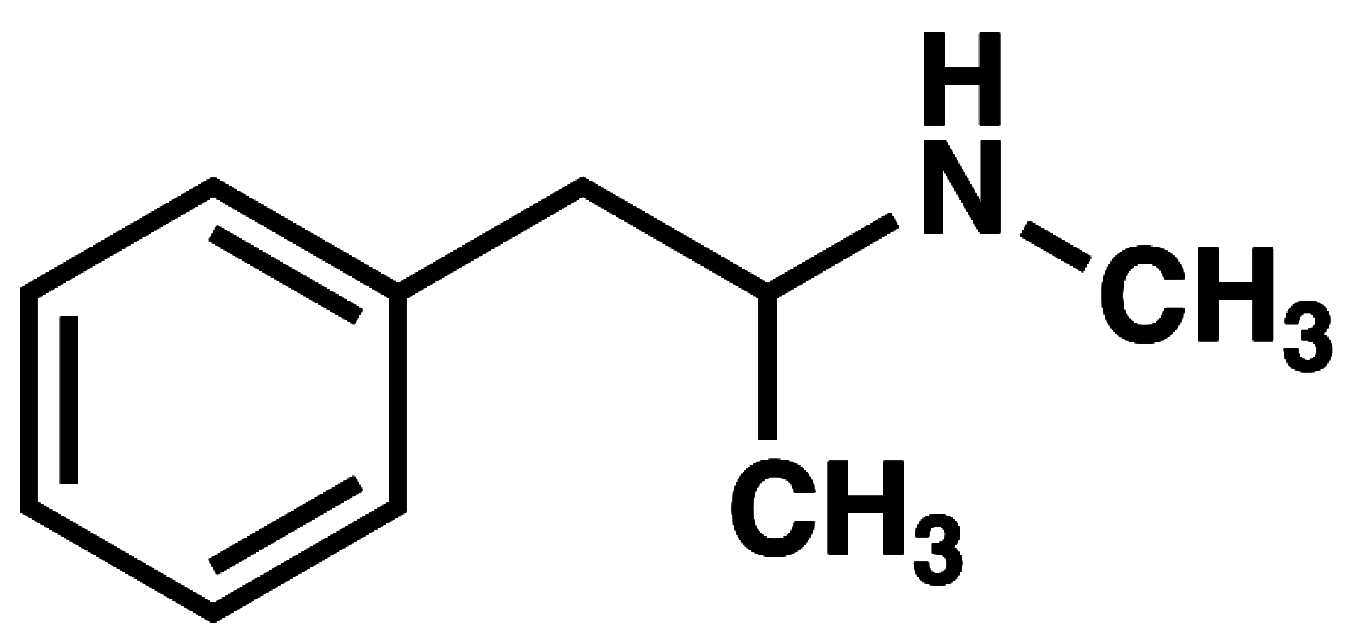MOLECULAR STRUCTURE of METHAMPHETAMINE
METH 101
Methamphetamine is closely related to amphetamine. Amphetamines are classified as stimulant drugs. Stimulants amp central nervous system activity, increasing your heart rate and making your blood pressure go up. Meth crosses the blood/brain barrier faster than amphetamine, triggering a massive flood of dopamine, the brain’s “feel good” chemical. The result is an intense high that can last up to 8 hours (or more) depending upon a person’s tolerance.
Street Names
Side, Meth, Crystal Meth, Speed, Jib, Ice, Chris, Crank, Tweek, Glass, Crystal, Crissy, Tina
Appearance
Side usually comes in crystal form but can also be a powder. The powder is white, beige, orange, pink, and variations in between. As crystal it is often clear to white, but sometimes blue/green and looks like pieces of crushed ice.
Meth has a bitter, chemical taste, sometimes a strong smell, but you can’t depend on smell or taste to determine purity.
*Always get your drugs tested at your local harm reduction organization to find out what’s in them! Sometimes meth can be tainted with fentanyl. Carry Naloxone and know how to use it!
Ingredients
Meth is a synthetic drug. Ephedrine and pseudoephedrine are main ingredients. Common chemicals used in the meth making process also include: hydroidic acid, red phosphorus, iodine, benzene, ethyl ether, acetone, and lye.
Some of these are toxic and known carcinogens.
Legality
Meth is a Schedule 1 drug in Canada. It carries a maximum penalty of seven years for possession. The maximum penalty for trafficking, producing, importing/exporting, or possession for the purpose of export is life imprisonment.
In the US, meth is a Schedule II drug and is only legal with a doctor’s prescription.
The High
On meth your pupils open wide, you feel alert, euphoric, and focused. You have increased energy, can become more talkative, or sometimes very introspective and self interested. Your temperature rises, digestion slows, and your appetite lowers. Meth users report feeling a strong sense of confidence on speed and may become super sexually aroused.
For certain people, especially with severe ADHD, side can mellow them out.
Methamphetamine is closely related to amphetamine. Amphetamines are classified as stimulant drugs. Stimulants amp central nervous system activity, increasing your heart rate and making your blood pressure go up. Meth crosses the blood/brain barrier faster than amphetamine, triggering a massive flood of dopamine, the brain’s “feel good” chemical. The result is an intense high that can last up to 8 hours (or more) depending upon a person’s tolerance.
Street Names
Side, Meth, Crystal Meth, Speed, Jib, Ice, Chris, Crank, Tweek, Glass, Crystal, Crissy, Tina
Appearance
Side usually comes in crystal form but can also be a powder. The powder is white, beige, orange, pink, and variations in between. As crystal it is often clear to white, but sometimes blue/green and looks like pieces of crushed ice.
Meth has a bitter, chemical taste, sometimes a strong smell, but you can’t depend on smell or taste to determine purity.
*Always get your drugs tested at your local harm reduction organization to find out what’s in them! Sometimes meth can be tainted with fentanyl. Carry Naloxone and know how to use it!
Ingredients
Meth is a synthetic drug. Ephedrine and pseudoephedrine are main ingredients. Common chemicals used in the meth making process also include: hydroidic acid, red phosphorus, iodine, benzene, ethyl ether, acetone, and lye.
Some of these are toxic and known carcinogens.
Legality
Meth is a Schedule 1 drug in Canada. It carries a maximum penalty of seven years for possession. The maximum penalty for trafficking, producing, importing/exporting, or possession for the purpose of export is life imprisonment.
In the US, meth is a Schedule II drug and is only legal with a doctor’s prescription.
The High
On meth your pupils open wide, you feel alert, euphoric, and focused. You have increased energy, can become more talkative, or sometimes very introspective and self interested. Your temperature rises, digestion slows, and your appetite lowers. Meth users report feeling a strong sense of confidence on speed and may become super sexually aroused.
For certain people, especially with severe ADHD, side can mellow them out.
Risks
Doing meth can result in serious health risks. Some meth related harms include:
*Death
*Overdose
*Dependency
*Heart Problems
*Sores (from picking/scratching)
*Dental Issues
*Paranoia
*Blood Borne Infections
*Anxiety
*Psychosis
*Insomnia
*HIV and/or Hepatitis C (from sharing smoking and injecting gear)
*Sexually Transmitted Infections (from having unprotected sex)
Doing meth can result in serious health risks. Some meth related harms include:
*Death
*Overdose
*Dependency
*Heart Problems
*Sores (from picking/scratching)
*Dental Issues
*Paranoia
*Blood Borne Infections
*Anxiety
*Psychosis
*Insomnia
*HIV and/or Hepatitis C (from sharing smoking and injecting gear)
*Sexually Transmitted Infections (from having unprotected sex)
